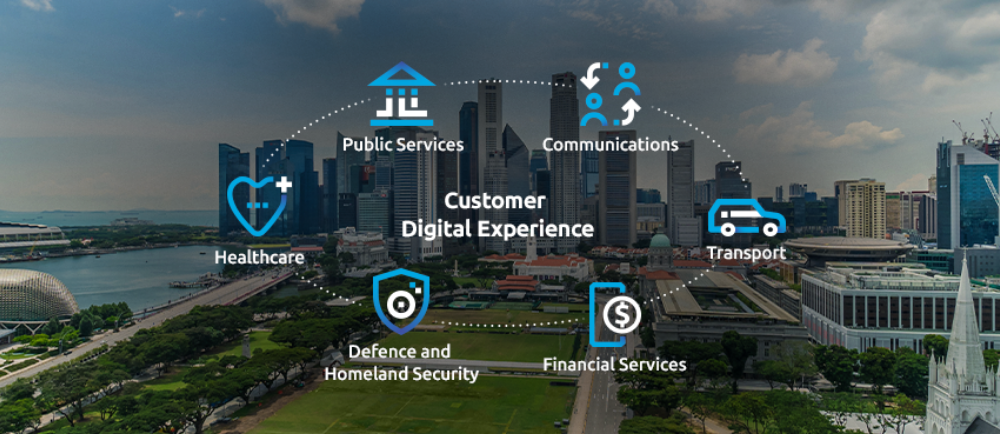Published: Jul 26, 2022
how hyper-digitalisation is taking shape across sectors
In the age of hyper-digitalisation, things move fast. New digital technologies are seemingly emerging every day and, as they gain traction in all spheres of life, these technologies are transforming organisations and entire industries at an unprecedented rate. In this article we’ll be looking at some of the most significant technological trends driving change in six key industries.
Sectoral shifts
Across sectors there are some universal truths. It has almost become a cliché to say that consumers and citizens today are more informed, connected and demanding than ever, but it’s undeniably true. They expect the highest standards of speed, availability, personalisation, choice, and security in all their digital interactions.
This means governments and enterprises across all sectors need to have a 360-degree view of their customers’ online digital experience and journey. They need to leverage data and analytics in new ways to harness insights to tailor their experiences. Beyond this, we’ve noticed some sector-specific trends.

Public services: A collaborative whole-of-government approach
The importance of citizen digital services has never been clearer than in recent times. Disruption caused by the COVID-19 pandemic has shown how vital efficient and seamless digital infrastructure and interactions are to government. To achieve this, governments have to adopt a whole-of-government approach and to create a truly digital end-to-end experience for citizens.

Healthcare: More personalised and more effective
COVID-19 has also rapidly accelerated the technological demand of the healthcare sector. Solutions for minimising human contact in healthcare environments and tracing infections have played critical roles in the battle against the pandemic. But behind the scenes, we’re also seeing increasing utilisation and adoption of advanced analytics and data-driven care, where patient data can inform more efficient, more effective, and more personalised care.
Defence and homeland security: Safer communities enabled by advanced video analytics
Technology’s role in defence and homeland security continues to grow at pace. And as new technologies such as AI and machine learning emerge, the contribution technology can make to safer communities will only grow. One notable trend is the increasing focus on the integration of advanced video analytics for surveillance and homeland security.
Transport: AI in the driver’s seat
Despite the pandemic bringing so much travel to a halt, we’ve also seen demand for and development of new innovations in the transport sector. We’re seeing the true advent of autonomous vehicles and the early signals of them moving into the mainstream, powered by 5G connectivity. But also, AI is playing its part to support drivers themselves, with increasingly intelligent navigation and driver-centric systems.
Financial services: Enhanced cyber security and fraud detection
In financial services, cyber security is a key priority for many organisations as threats become ever-more sophisticated. Many are using analytics to fight smart in the battle against scammers and monitoring transaction data to spot potentially fraudulent activity.
Reward and loyalty points systems have also been highlighted as a weak point for hackers, where stronger infrastructure is needed to protect businesses. Banks and other institutions are also increasingly looking to create new ways to securely share data to help combat fraud and money laundering.
Communications: New revenue streams driven by 5G, AI, and the Cloud
The telecommunications landscape has been changing dramatically and this is set to continue. New revenue streams are arising with the rollout of 5G. The new applications and services possible with 5G will create whole new opportunities for network providers.
There are many tech forecasts and predictions for the year ahead, but they all have something in common, or rather some things. There are 3 technologies that are driving almost all of these new trends — artificial intelligence, 5G, and the Cloud — and these all feed into one another.
Artificial Intelligence is here, and the impact is real
There’s no doubt that artificial intelligence has gone from something lots of people were talking about and few were actioning, to something that’s in practical application across a whole host of sectors and use cases.
As artificial intelligence continues to become a staple element in organisations’ technology mix, we’re seeing increasing demand for more strategic partnerships, where broader support is needed in utilising the full potential of data, analytics, and AI.
The skills gap that has opened across the industry with the advent of AI means organisations are struggling to attract and retain talent with the diverse skillset and experience required at different stages of their journey.
5G making waves in reality

In many ways, 5G is the magic ingredient that will make so many of the incoming innovations possible. With its ultra-low latency, significantly bigger bandwidth and faster speed, 5G’s impact on industries and businesses is hard to underestimate. On top of increased operational efficiency through automation or the ability to perform remote operations securely, whole new possibilities will come into view.
5G will also accelerate the adoption of edge computing, feeding into the trends of distributed and de-centralised applications. We’re also seeing it accelerate Internet of Things (IOT) development and cloud adoption across enterprises, creating a tsunami of data that needs to be managed, but also driving demand for machine learning (ML) and advanced analytics solutions to turn all of this data into valuable insights.
Overall, 5G is driving a real paradigm shift towards edge computing and distributed architecture which will have ripple effects across all industries and sectors. It’s igniting a fundamental change in data management, security and distributed applications, all big changes that organisations will need help to navigate.
Cloud becomes the norm
The huge growth in data demands driven by Big Data, IoT, and now 5G devices and the hunger for pure computing power from advanced analytics, which can’t be met by traditional data centres, are all coming together to create the perfect storm for the Cloud.
Together with the overall pace of digital transformation and changing macro environments, organisations are no longer able to forecast infra requirements way ahead for procurement. This agility can only be supported by the Cloud.
How we’re responding to these changes
We’ve been reshaping our business and strategising to help meet these new demands and adapt to these trends. From introducing new specialised service organisations such as Gov+ and Telco+ to drive public sector and communications innovation, to instilling a whole new culture of talent development and creating a broader and stronger partner ecosystem. To answer this demand for innovation across the region, we’ve created our Innovation triangle, connecting Singapore, Melbourne, and Shenzhen to share talent and expertise across borders and drive progress in all markets. This model of co-creation and cross-pollination of ideas will help us lead the way into the future.
Organisations are increasingly hyperconnected with their partners, their suppliers, their customers and other stakeholders, and NCS is no different. We’re building a hyper-connected partnership ecosystem with clients, tech partners, and industry players to fuel innovation and co-creation.
To learn more about what’s ahead in technology, read more of our Future Trends series with the links below.

